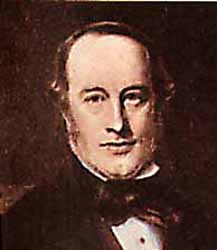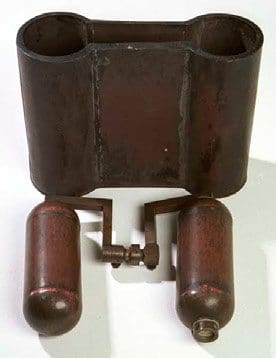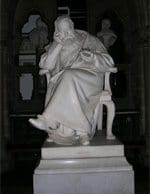
James Prescott Joule was born on Christmas Eve 1818 into a wealthy Salford brewing family. A sickly child, he was tutored at home where he indulged his fascination for electricity by using a voltaic cell to give electric shocks to the family servants! At the age of 16 he was sent to the Manchester Literary and Philosophy Society (Lit & Phil) to be taught chemistry, physics, mathematics by the eminent Manchester scientist, John Dalton (1766-1844; developer of the atomic theory of matter).
Together with the physicist William Thomson (later Baron Kelvin), Joule found that the temperature of a gas falls when it expands without doing any work. This principle, which became known as the Joule-Thomson effect, underlies the operation of common refrigeration and air conditioning systems.
Joule in his twenties
Joule managed the family brewery from 1837 to 1856 which enabled him to experiment on the relationships between heat and electricity in a laboratory built in the cellar of his father’s home. His earliest experiments explored the relationships between electricity and work and in 1840, he published a paper in the Proceedings of the Royal Society describing the first of the eponymous laws which predicts the heat generated by a conductor from its resistance and the current applied.
Later in Joule’s life this information was to prove instrumental in determining that high-voltage power lines were the most efficient way of conveying electricity from power stations to consumers.
In 1843, Joule showed that heat was a form of energy and determined the physical constant now used as the S.I. unit for energy, the Joule (J). He demonstrated the mechanical equivalent of heat by measuring change in the temperature of water caused by the friction of a paddlewheel attached to a falling weight.
This concept was further tested on his honeymoon in 1847 with his patient new bride Amelia Grimes, when Joule measured the temperature difference above and below the Sallanches waterfall in Switzerland!

Up to then most scientists believed in the caloric theory that heat could neither be created nor destroyed. Joule’s theory was so controversial that he could not find a scientific journal to publish it. It first appeared in a local Manchester newspaper. However, William Thompson (later Lord Kelvin) supported Joule’s theory and collaborated with him to examine heat changes when gases expand and contract. Results of these studies paved the way for the development of the refrigerator.

Over the same years, Joule also invented ‘arc’ or electrical welding, and the displacement pump. Despite carrying out admirable research to improve the quality of beer, Joule’s brewery was in a poor financial state and in 1875 his funds ran out.
With the support of members of the Lit & Phil, Joule was granted a Civil List pension of £200 p.a. for services to science.
Sickness dogged his final years and he died on 11 October 1889 in his house at 12, Wardle Road, Sale, Manchester.
Joule never took an academic appointment but was made FRS (1850) and awarded the prestigious Royal (1852) and Copley (1872) medals in recognition of his achievements. He received honorary doctorates from Dublin, Oxford and Edinburgh universities. His achievements are recognised by a memorial tablet in the South choir of Westminster Abbey and more recently, a crater on the moon has been named after him.
After his death the Lit & Phil raised money from local industrial firms, many of which had directly benefited from his scientific findings, to commission a statue of Joule. Sculpted by Alfred Gilbert R A, this now stands opposite that of his former tutor, John Dalton, in the entrance foyer of Manchester Town Hall.
Summary

James Prescott Joule, an ‘amateur’ scientist and inventor, combined brilliant scientific thinking and innovation with the brewer’s interest in highly accurate measurements. His findings and publications greatly improved the efficiency of many 19th century industrial machines and processes including steam engines, electric motors and transmission of electrical power.
The principles that Joule described directly led to the important developments of arc welding and refrigeration. Joule’s best known legacy is the eponymous unit that was officially adopted as the S.I. unit for energy by the ‘Bureau International des Poids et Mesures’ in 1948.










